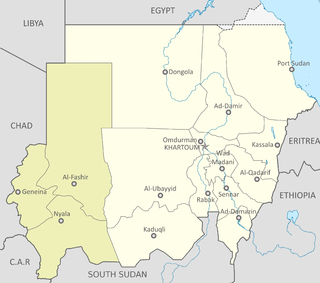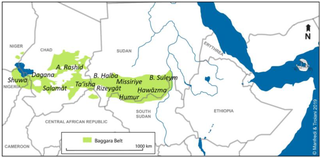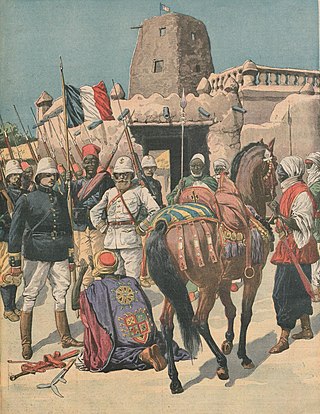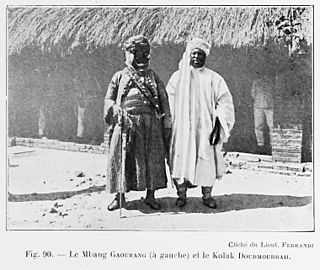
Darfur is a region of western Sudan. Dār is an Arabic word meaning "home [of]" – the region was named Dardaju while ruled by the Daju, who migrated from Meroë c. 350 AD, and it was renamed Dartunjur when the Tunjur ruled the area. Darfur was an independent sultanate for several hundred years until it was incorporated into Sudan by Anglo-Egyptian forces in 1916. As an administrative region, Darfur is divided into five federal states: Central Darfur, East Darfur, North Darfur, South Darfur and West Darfur. Because of the War in Darfur between Sudanese government forces and the indigenous population, the region has been in a state of humanitarian emergency and genocide since 2003. The factors include religious and ethnic rivalry, and the rivalry between farmers and herders.
The Kujargé language is spoken in seven villages in eastern Chad near Jebel Mirra, and in villages scattered along the lower Wadi Salih and Wadi Azum in Darfur, Sudan. It is estimated to have about 1000 speakers.

Ta'isha, or Ta'aisha, or Taaisha, one of a series of Arabic-speaking groups collectively called Baggara "cattle people", who live in Sudan, across southern Kordofan, Darfur, as well as Chad. The Ta'aisha tribal homeland is in the far southwest of Darfur, neighbouring to the east the Habbaniya, with whom they are closely related. The Ta'aisha rose to power when one of the members of their tribe, Abdallahi ibn Muhammad, later known as the Khalifa, became an early follower of Muhammad Ahmad, who would later become the Sudanese Mahdi. During the revolution, 'Abdallahi became the strongman of the movement and was designated as senior Khalifa by the Mahdi. Following the Mahdi's death in June 1885, the Khalifa 'Abdallahi ruled the Mahdist state until its destruction by an Anglo-Egyptian army. The Khalifa during his rule brought his tribe to Central Sudan and he went on to make extensive use of his relatives and other fellow Ta'a'isha as soldiers and administrators. Throughout the Mahdist period there was constant tension between the Ta'aisha leaders and the riverain Sudanese. Several Ta'aisha amirs who survived the Mahdiyya became prominent at the re-established Darfur Sultanate of Ali Dinar, one being Arabi Dafallah, who was appointed commander of the Equatorial province with its headquarters at Rejaf under the Khalifa's rule. Having been forced in 1897 to evacuate Equatoria by Belgians advancing from the Congo, he had made his way into southern Darfur where he faced Anglo-Egyptian forces and friendly tribes sent by Kitchener in pursuit of him. He then settled in the area of the present Central African Republic-Darfur border where he came into contact with encroaching French colonial power. After an unsuccessful attack on French outposts in the region he surrendered to Sultan 'Ali Dinar with his men and their arms in 1902, he subsequently lived in Al-Fashir and took part in many of the Sultan's military expeditions. Another one was 'Ali al-Sanusi, who was a Mahdist amir under Mahmud Ahmad in Atbara and fought at Karari after which he escaped to Darfur to be one of 'Ali Dinar's best generals. Under the British colonial rule, He was appointed Nazir of the Ta'aisha in Darfur and rendered valuable service to the new administration.

The Wadai Sultanate was an African sultanate located to the east of Lake Chad in present-day Chad and the Central African Republic. It emerged in the seventeenth century under the leadership of the first sultan, Abd al-Karim, who overthrew the ruling Tunjur people of the area. It occupied land previously held by the Sultanate of Darfur to the northeast of the Sultanate of Baguirmi.

Al Fashir, Al-Fashir or El Fasher is the capital city of North Darfur, Sudan. It is a large town in the Darfur region of northwestern Sudan, 195 kilometres (121 mi) northeast of Nyala, Sudan. A historical caravan post, Al-Fashir is located at an elevation of about 700 metres (2,300 ft). The town serves as an agricultural marketing point for the cereals and fruits grown in the surrounding region. Al-Fashir is linked by road with both Geneina and Umm Keddada. Al-Fashir had 264,734 residents as of 2006, an increase from 2001, when the population was estimated to be 178,500.

Ouaddaï is a region of Chad, located in the south-east of the country, with its capital at Abéché. Prior to 2002 it was known as Ouaddaï Prefecture; in 2008 the southern portions of Ouaddaï were split off to become the new Sila Region.

The Messiria, known also under the name of Misseriya Arabs, are a branch of the Baggara ethnic grouping of Arab tribes. Their language is the Sudanese Arabic. Numbering over one million, the Baggara are the second largest ethnic group in Western Sudan, extending into Eastern Chad. They are primarily nomadic cattle herders and their journeys are dependent upon the seasons of the year. The use of the term Baggara carries negative connotations as slave raiders, so they prefer to be called instead Messiria.

The Wadai War was waged by France and its African allies against the Wadai Empire and its allies from 1906 to 1912. Located in what today would be eastern Chad and western Sudan, Wadai fiercely resisted the French invasion. Regardless, much of Wadai including its capital Abéché fell to the invaders in 1909, forcing the empire's ruler Dud Murra to continue his resistance from outlying provinces and allied states. He managed to gain the support of the Sultanate of Darfur and Dar Masalit, and used these areas as rear bases during his attempts to oust the French. Doing so, he enjoyed some success, and inflicted several defeats on French-led forces. In order to legitimize their intervention, the French installed Dud Murra's relative Adam Asil as puppet ruler in Wadai. After losing most of his forces and allies, Dud Murra was forced to surrender in 1911. Regardless, unrest initially continued: a major anti-French revolt broke out soon after Dud Murra's defeat, and an anti-European conspiracy was allegedly organized with the support of Adam Asil. The last effective anti-French resistance in Wadai was suppressed by 1912 and the region remained a part of French colonial empire until 1960.
Tama are a non-Arab, African ethnic group of people who live in eastern Chad and western Sudan. They speak Tama, a Nilo-Saharan language. The population is 200,000–300,000 people and they practice Islam. Many Tama are subsistence farmers who live in permanent settlements and some raise livestock. In the civil war in Chad (2005–2010) the Tama were involved in ethnic conflicts with the Zaghawa tribe.
Goz Beïda is the capital of the Sila region of Chad, as well as the main town (chef-lieu) of the Kimiti department. Prior to 2008, Goz Beïda was part of the Ouaddaï Region's former Sila Department.

Throughout its history, Darfur has been the home to several cultures and kingdoms, like the mythical Tora or the Daju and Tunjur kingdoms. The recorded history of Darfur begins in the seventeenth century, with the foundation of the Fur Sultanate by the Keira dynasty. In 1875, the Anglo-Egyptian Co-dominion in Khartoum ended the dynasty. The British allowed Darfur a measure of autonomy until formal annexation in 1916. However, the region remained underdeveloped through the period of colonial rule and after independence in 1956. The majority of national resources were directed toward the riverine Arabs clustered along the Nile near Khartoum. This pattern of structural inequality and overly underdevelopment resulted in increasing restiveness among Darfuris. The influence of regional geopolitics and war by proxy, coupled with economic hardship and environmental degradation, from soon after independence led to sporadic armed resistance from the mid-1980s. The continued violence culminated in an armed resistance movement around 2003.
The Daju people are a group of seven distinct ethnicities speaking related languages living on both sides of the Chad-Sudan border and in the Nuba Mountains. Separated by distance and speaking different languages, at present, they generally have little cultural affinity to each other.

The Sultanate of Darfur was a pre-colonial state in present-day Sudan. It existed from 1603 to October 24, 1874, when it fell to the Sudanese warlord Rabih az-Zubayr and again from 1898 to 1916, when it was conquered by the British and integrated into Anglo-Egyptian Sudan. At its peak in the late 18th and early 19th century it stretched all the way from Darfur in the west to Kordofan and the western banks of the White Nile in the east, giving it the size of present-day Nigeria.

Sila or Dar Sila is a region of Chad, located in the south-east of the country. It was created in 2008 from the departments of Sila and Djourf Al Ahmar which were previously part of Ouaddaï Region. The capital of the region is Goz Beïda.
Muhammad 'Abd al-Karim Sabun was (Sultan) of Wadai, a Muslim state in what is now eastern Chad, from 1804 to 1815. He pursued an expansionist policy, and was the greatest of the rulers of Wadai.

Muhammad Salih bin Yusuf, known as Dud Murra or Dudmurrah, was the last independent ruler, or kolak, of the Wadai Empire. He allied with the Sanusi, powerful traders of the eastern Sahara, and with the Sultan of Darfur to resist French aggression in the eastern Sahel, but was defeated. His sultanate was incorporated in the French military territory of Chad.

The Daju kingdom was a medieval monarchy that existed in Darfur (Sudan) from possibly the 12th–15th century. Its name stems from the Daju people, the ruling ethnic group. The Daju were eventually ousted from power by the Tunjur and the last Daju king subsequently fled to present-day Chad. The sources for the Daju kingdom are almost entirely local traditions collected in the 19th and 20th century and mentions by medieval Arab historians.
The Kujarke people are a little-known ethnic group of the Ouaddaï Region in eastern Chad and South Darfur, Sudan. They speak Kujargé, a divergent, unclassified Chadic language. Their current population and locations are unknown due to the war in Darfur. Furthermore, they have not been previously recorded as a separate ethnic group by any government or foreign aid organization.
The 2020 LINAFOOT was the 4th season of the LINAFOOT, the top Chadian league for association football clubs since its establishment in 2015.











